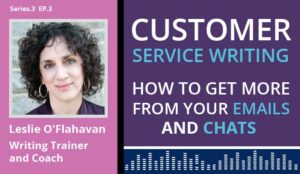Leslie O’Flahavan writing for Playvox explains how to improve your email first response time.
Email is not the shiny new channel in the contact centre. Customers have been using email for years, they continue to use it, and they like email.
Over the years, however, their expectations about first response time definitely have changed. There’s no question they expect a faster response than they did back in the day.
Jeff Toister’s research found that 31% of customers want an email response from a company in one hour or less! The old standard “We have received your email and will reply within two business days” is out the window.
How can contact centres improve their email response time? It’s not by increasing the email quota for individual agents. Contact centres can only improve response time when managers choose the right people, knowledge management practices, workflow, and tools to enable faster-better email.
People Tips
1. Hire People Who Like to Write and Are Good At It
If you’ve been accustomed to moving agents from the phone to email, you may have created a team that doesn’t have very good writing skills. Make a long-term plan to recruit agents who can write. You can’t expect people who are just OK at writing to be able to do it more quickly.
You simply need agents who have good writing skills. (Want some ideas on how to screen applicants for writing skills? Download this checklist: “Nine interview questions you must ask applicants about their writing skills.”)
2. Staff Your Email Channel With People Who Can Easily Blend Freetext With “Canned” Writing
If you’re trying to get your agents to answer customers’ emails quickly, it makes sense to use templates. But sending customers responses that are 100% canned is a bad idea. It destroys your brand reputation and just creates more emails of the “Thanks for the form letter that didn’t even answer my question” variety. Instead, staff your channel with people who can freetext within a template or put the template aside and freetext the entire response when necessary.
3. Hire People Who Have Excellent Analytical Reading Skills
Can your email agents read the customer’s email and understand the difference between what the customer is saying and what they’re asking? That’s analytical reading, and it’s an essential email skill.
Let’s consider a sample email from a customer, “Charlie.”
If the agent lacks analytical reading skills, they might skim through Charlie’s email quickly and notice Charlie is saying he’s having trouble placing an online order.
The only question Charlie has actually asked in his email is “What’s going on??” An agent who’s not good at analytical reading will write a reply to Charlie’s literal question, and that reply won’t be of much use, however quickly Charlie receives it.
A close, analytical reading of Charlie’s email shows that he’s actually asking several questions:
- How do I place my order?
- Did I make a mistake or is your system broken?
- Did my order, in fact, go through?
An agent who uses analytical reading skills and writes a full response that answers Charlie’s implied questions is actually more efficient. The full response, delivered quickly, is far more likely to be the final response.
Knowledge Management Tips
4. Name Your Knowledge Base Articles Unambiguously
It’s the manager’s responsibility to enforce good KB article naming practices, so agents can easily find the KB article they need. These KB article names are too similar to be of use. They will make agents slow to find the information they need:
- Refund Policy – International Customers – Original
- Refund Policy – International Customers – Updated
- Refund Policy – International Customers – With Link to Form Version 2
5. Provide a Library of Useful, Current Email Templates That Make Freetexting Easy
The manager should ensure that the templates agents use in their email responses encourage writing that’s both fast and good. These templates should include:
- Placeholders. Agents simply swap in specific information such as model numbers or dates, etc.
- Prompts. Agents follow the prompt by freetexting. The prompt might be for an empathy statement or a summary of the steps the agent has taken to solve the problem.
- Whitespace. Templates that are composed of short paragraphs separated by whitespace are easier to customize than templates composed of longer paragraphs or big blocks of text.
A sample template used by an air conditioner manufacturer. This template includes a mix of placeholders and prompts. Its short paragraphs would make it easy to customize.
Workflow Tips
6. Route Incoming Emails, So Individual Agents Are Answering Emails That Are All on the Same Topic
This workflow practice will enable agents to answer emails faster, so if speed is your top priority, you may want to consider it. Routing emails by topic has a well-known downside: it makes agents’ work boring and repetitive. Perhaps this tip is best used if there’s been a crisis and your team needs to clear a backlog?
7. Allow Agents To Focus On Email
Avoid having agents split their attention by doing chats or phone calls between emails. While filling in any down time between calls may seem efficient, it breaks agents’ focus and prohibits analytical reading or freetexting within templates. Efficient email writing requires focus.
Tool Tips
8. Equip Agents With a Spell-Checker That Actually Works
To write quickly, and accurately, your agents need a spell-checker that (a) can be customized and (b) has an autocorrect function.
A non-customizable spell-checker will tell agents that your product names are spelled incorrectly, even if your brand does sell actually sell knit caps it calls “Hatts.”
And a spell-checker that also has an autocorrect function will catch and correct innocent but embarrassing keyboarding errors, by replacing “pucrhase” with “purchase,” for example.
9. Integrate a Grammar Checker Like Grammarly
Most CRMs have less-than-helpful grammar checkers built in. If you want to help agents spend less time proofreading their emails (and help them write emails with fewer errors), give them a better grammar checker. Let Grammarly find—and fix—those comma errors!
It’s pretty easy to pressure agents to improve first reply time, but badly written email always begets more email. Managers will never improve their team’s email efficiency unless they support agents to write high-quality email … quickly.
Author: Guest Author
Published On: 16th Aug 2022 - Last modified: 30th Nov 2023
Read more about - Guest Blogs, Leslie O'Flahavan, Playvox





































